|
|
|
Sort Order |
|
|
|
Items / Page
|
|
|
|
|
|
|
| Srl | Item |
| 1 |
ID:
147198
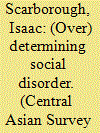

|
|
|
|
|
| Summary/Abstract |
This article analyses the rise of social unrest in the Tajik SSR in 1990–1991 from the perspective of the republic’s place within the broader Soviet economy and the collapse of that economy over the course of perestroika (1985–1991). Countering standard narratives of glasnost, democratization and nationalism in Tajikistan, it demonstrates that a close reading of the historical record points to sharp economic downturn as the most plausible immediate cause of the social disorder that came to engulf the Tajik SSR in the final years of the USSR and led to the Tajik Civil War of the 1990s.
|
|
|
|
|
|
|
|
|
|
|
|
|
|
|
|
| 2 |
ID:
147197
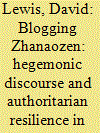

|
|
|
|
|
| Summary/Abstract |
Post-Soviet authoritarian regimes – particularly in Central Asia – have proved highly resilient since independence. Existing explanations for regime longevity should be augmented by consideration of non-material, discursive sources of political legitimacy. A robust authoritarian regime requires the production and circulation of a hegemonic discourse that is internalized by influential social groups. This type of dominant discourse has emerged in Kazakhstan, making it difficult for political opponents to promote alternative political imaginaries and mobilize popular support. State control over media is challenged by Internet-based platforms, but in Kazakhstan social media and blogging have also offered an opportunity for the regime to reproduce its own hegemonic discourse. This article uses a discourse analysis of posts by bloggers in the aftermath of a violent conflict in Zhanaozen in Kazakhstan in 2011 to demonstrate how central elements in the state discourse are reproduced online, even by independent bloggers, suggesting that an official discourse has the ability to maintain its hegemonic status despite widespread use of blogs and social media.
|
|
|
|
|
|
|
|
|
|
|
|
|
|
|
|
| 3 |
ID:
147193
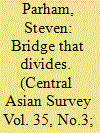

|
|
|
|
|
| Summary/Abstract |
The collapse of the Soviet Union in 1991 brought profound changes to the borderlands of Kyrgyzstan, Tajikistan and Xinjiang. In eastern Kyrgyzstan and Tajikistan’s Gorno-Badakhshan region, present-day weaknesses in territorial control of the post-Soviet state’s edges are directly wedded to borderlanders’ memories of Soviet-era practices of bordering, perceived locally as both systemically stronger and cognitively more beneficial to local lifeworlds than contemporary ‘Chinese penetration’. Across the border in Xinjiang, a formerly distant state has been brought into borderlanders’ locales and inscribed into everyday lifeworlds through novel manifestations of the state, which significantly affect cross-border interaction. By comparing how borderlanders on both sides of this frontier themselves choose to characterize border processes between ‘their’ states in the initial two decades of connections to Xinjiang, I explore how and why Kyrgyz and Tajik/Pamiri borderlanders voice strong opinions about what it is they feel has changed in these administrative-territorial homelands. Based on extensive ethnographic fieldwork on both sides of this frontier, I argue that the gradual bridging of this formerly sealed border has led to neither the development of a new trans-frontier identity nor locally established trans-frontier networks but, instead, reconfirmed borders between China and Central Asia.
|
|
|
|
|
|
|
|
|
|
|
|
|
|
|
|
| 4 |
ID:
147196
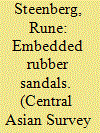

|
|
|
|
|
| Summary/Abstract |
How does a group of Uyghur traders from a village in Atush (Xinjiang, China) end up with a stock of unsellable rubber sandals in Kadamjay (Batken, Kyrgyzstan), and why don’t they compete according to market principles? This article explores the social investments of the traders and their families, and reveals their behaviour to be rational, both economically and socially. It illuminates the business and daily life of Uyghur traders in southern Kyrgyzstan, an environment that is increasingly challenging and uncertain. The examination of exchange relations between their households explains why the traders cooperate as they do and also why they do not cooperate more. Economic rationales and social obligations prove to be mutually embedded. This insight expands and deepens a nascent analytical approach that recognizes social motivation for economic activities in Central Asia alongside undeniable economic incentives. This approach has much to gain from being more explicitly reconnected to classical anthropological theories of gift giving.
|
|
|
|
|
|
|
|
|
|
|
|
|
|
|
|
| 5 |
ID:
147194
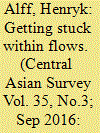

|
|
|
|
|
| Summary/Abstract |
For more than two decades, the Sino–Soviet border was almost hermetically closed to the exchange of people and goods. In the late 1980s, however, exchanges resumed at a remarkable pace between the immediate border communities of Zharkent, in Kazakhstan, and Chinese Khorgos. But this situation was short-lived. Currently, trade turnover in consumer goods between the two countries is conducted primarily via the hub bazaars of Urumqi, in China, and Almaty, in Kazakhstan, several hundred kilometres inland from the border. While the borderland population’s agency in these trade processes remains limited, top-down modernization efforts to upgrade infrastructure in the borderlands and to ‘centralize the periphery’ are the subject of popular controversy. The article explores local representations of development and exchange in the Kazakhstan–China borderland town of Zharkent and the everyday social practice and discourses they generate. I examine the peripheralization of this borderland community, which remains largely bypassed by commodity flows, at a moment characterized by multi-scalar attempts at modernization. In so doing, I argue that the trajectories of borderland lives perpetuate a subjective positioning in social space that reinforces perceptions of ‘remoteness’ and ‘disconnection’, despite powerful state-advocated visions of modernity.
|
|
|
|
|
|
|
|
|
|
|
|
|
|
|
|
| 6 |
ID:
147195
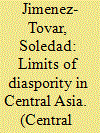

|
|
|
|
|
| Summary/Abstract |
This article shows different ways of defining, understanding and performing ‘diaspority’ in the border region of Kordai (Kazakhstan) and Tokmok (Kyrgyzstan). Taking the example of Dungan people, as the Sinophone Muslims are known in Central Asia, both academic and political definitions of the concept of ‘diaspora’ are compared. This ethnographic account problematizes Kazakhstani Shaanxi Dungan ‘diaspority’. Together with this, the political definitions of ‘diaspora’ are also analysed. I show that while in China and Kazakhstan the definitions of the Dungans as a ‘diaspora’ of ‘China’ are somewhat complementary, once the Shaanxi Dungan emic perspective is taken into account, this concept becomes rather problematic. The kinds of diaspority defined by the states involved are ways of implementing particular cultural hegemonies that legitimate the two political regimes analysed in this article. Concurrently, this dual diaspority is used by the Dungan people in distinct ways in defining their own identities. Nevertheless, I show in this article that the ‘Chinese card’ is not necessarily played by all Dungans. Moreover, there are some Dungans for whom ‘Chinese-ness’ is not even relevant.
|
|
|
|
|
|
|
|
|
|
|
|
|
|
|
|
| 7 |
ID:
147192
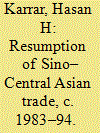

|
|
|
|
|
| Summary/Abstract |
The resumption of trade across the Sino–Central Asian border in 1983 accompanied a gradual thaw in relations between China and the Soviet Union. This paper argues that: (1) Economic liberalization in China (alongside the Soviet Union) created a climate encouraging cross-border exchange. (2) Starting in 1983, improving relations between China and the Soviet Union permitted cross-border exchange in Central Asia; over the subsequent decade, trade volume served as a marker of bilateral relations. (3) Beginning in 1990, efforts by the Chinese leadership to accelerate reform in North-West China, coupled with the independence of Central Asian republics, led to a rapid increase in trade. Hence, the resumption of Sino–Central Asian trade was not grounded in meta-geographical projections – Silk Road, New Silk Road, Silk Road Economic Belt, Eurasian Continental Bridge – but determined by political and economic transitions in the two countries, accompanied by normalizing bilateral relations.
|
|
|
|
|
|
|
|
|
|
|
|
|
|
|
|
|
|
|
|
|